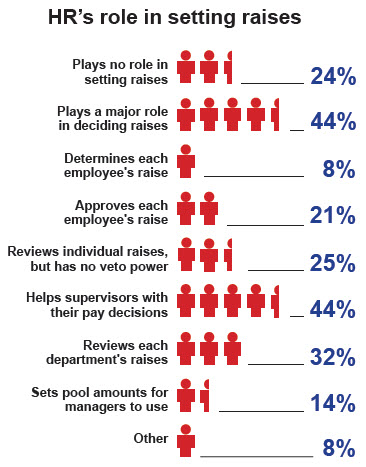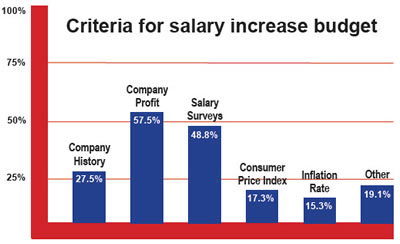In today’s Advisor, we’ll do our annual summary of our 2012 survey results—a good time to check your practices against those of thousands of other employers around the country.
Pay Budgets 2.5 to 3 Percent
Our survey revealed that most employers offered modest pay increases in 2012 and will do so again in 2013. In 2011 the average “planned” merit increase for 2012 was 2.1%. Actual merit increases for 2012, however, were higher than anticipated for the first time in at least two years, with the most commonly awarded amount being 2.5 to 3.0%.
Expectations for 2013 still reflect a slow recovery. Though 18% of the employers who responded to this question in our survey expect to offer 2013 merit increases of up to 2.5%, 22% planned no increase, 27.5% plan to offer merit increases of 2.5 to 5%, and 1% plan to offer increases above 5%.
HR budget cuts? Let us help. HR.BLR.com is your one-stop solution for all your HR compliance and training needs. Take a no-cost, no-obligation trial and get a complimentary copy of our special report Critical HR Recordkeeping—From Hiring to Termination. It’s yours—no matter what you decide.
The most common amount indicated for 2013 increases for exempt and nonexempt office workers was 2.5 to 3%. For hourly non-office workers, the most commonly planned increase was 2 to 2.5%.
Additional findings:
- Eight percent of survey respondents offered bonuses in lieu of raises in 2012
- 65% paid bonuses in addition to salary increases
- 20% awarded both bonuses and increases to their employees.
- 78% paid bonuses to their exempt employees in 2012 with 40% offering amounts of 5% or less and 32% awarding amounts of greater than 5%.
- In comparison, 47% of those surveyed awarded bonuses to their hourly non-office workers with 40% offering 5% or less and 7% awarding amounts greater than 5%.
Bonus projections for 2013 were still up in the air for most employers at the time of our survey, with only 9% of those surveyed indicating they plan to award bonuses in 2013. Twenty-three percent plan to offer no bonuses and 54% were undecided. Of those who had planned to award them, 8% will offer bonuses of up to 2.5% of base pay and 8% will offer 2.5 to 5%. Nine percent plan to award bonuses in lieu of raises, 34% will award bonuses in addition to salary increases, and 21% will award both bonuses and raises in 2013.

Most ‘Popular’ Policies
Almost all employers responding to our August survey have harassment and/or discrimination policies (94.5% have such a policy). Employee leave comes in as the second most widely implemented policy with 91.1%. Also above the 90% mark are computer and Internet use, confidentiality and proprietary information, along with PTO/vacation.
Surprisingly, only 25.5% of survey respondents update their policies annually. When asked which policies will be updated in 2012, 50% of respondents indicated social media is at the top of their list and attendance/punctuality is a priority for 30.8%, followed closely by cell phone/distracted driving and PTO/vacation for 30% of respondents each.
All policies apply to all employees for 63.9% of our survey respondents but for 21.5% some policies apply only to nonexempt employees and an almost equal number (20.9%) have policies that apply only to exempt employees. Interestingly, 14.4% have policies that apply only to production or operations workers while 10.8% have policies specifically for office staff.
HR management is the primary developer of policies for 81.8% of our survey respondents. Middle management is very involved for 10.6% of our respondents, marginally or somewhat involved for 68.2%, and not involved at all for 19.6%. Senior management participates in policy development for 59.3% and inside and/or outside legal counsel is involved for 39%. Senior management has final approval of policies for 64.4% of those responding to our survey.
Your HR Department—Outsourcing and On-Line Servicing
The majority of our survey respondents (59%) provide guidance to small or medium size employers with a workforce of 1-250 employees and 16% provide guidance to 251-500 employees at their organizations. When asked about staff to employee ratio, 36% indicated that their HR departments operate with a ratio of 1 HR professional to 101-200 or more employees and 13% operate with a ratio of 1 HR professional to 201 or more employees.
Though no significant changes had been experienced in the previous year by 50% of participants in our survey, 16% of the HR departments have been reduced in size and departmental budgets have been reduced for 15%. Automation initiatives have been undertaken by 23% while 3% have implemented shared services models and 5% increased outsourcing. Of those that do, the most frequently outsourced function is background/reference checks at 60%, followed by payroll for 38%, then unemployment and workers’ compensation claims processing at 28% and 27%, respectively. Benefits administration is outsourced by 23% of survey respondents.
The HR function most frequently provided as an online self-service feature to employees is the employee handbook, by 65% of our survey respondents. Name/address change is offered as self-service for 48% and time/attendance is made available online for 62%, with vacation/PTO requests available for 45%. Benefits administration is offered as a self-service feature by 49% of survey respondents.
Myriad challenges face respondents to our survey with recruiting leading the pack at 21% and health care coming in second at 16%. Rounding out the top three is employee motivation and retention.

Paid Time Off—FMLA and Recordkeeping the Biggest Headaches
When asked to describe their biggest employee leave challenge, FMLA and recordkeeping tied as the biggest problem with 20% each for those who responded to our survey, followed closely by scheduling for 16%. Leave abuse is a problem for 10% and consistent application is an issue for 7%. A lucky 4% have no or very few issues when it comes to managing employee leave.
Paid vacation time, separately or as PTO, is available to over 95% of survey respondents, while paid sick leave is an option for 85%. Paid personal days are available for 39% and 90% offer 6 or more paid holidays per year. Extended medical leave is offered by 27% and maternity/paternity leave is offered separate from other sick leave by 24%.
Paid time off to attend the funeral of a spouse, child, or parent is available for 98% of those who offer bereavement leave as a benefit. Brother and sister are included for 96%. Grandparent is included for 87% and grandchild is included for 79%. Stepparent and stepchild are included for 74% and 76% respectively. Mothers-in-law are included for 80% as are fathers-in-law, though brothers- and sisters-in-law are included for 60%. Extended family members are included for 25% and exes and his or her family members are included for 5%.
When asked whether survey participants deduct from exempt employees’ accrued leave to cover partial-day absences, 34% indicated they do not and 14% stated they do, with the amount of time depending on the situation. Twenty-two percent deduct in half-day increments, 10% deduct in hourly increments, 5% deduct half hours, and 11% deduct quarter hours.
Paid leave rollover is allowed by 70% of survey respondents. Use it or lose it, however, is the rule of thumb for 18.4% and, though they can’t roll it over, 4.4% reimburse employees for all or part of their unused paid leave. When asked which types of leave survey respondents pay out to employees when they leave the company, 61% pay for vacation, 8% pay out sick time, 44% pay out any unused PTO, and 7% don’t pay cash for unused paid leave.

Holidays—90 Percent Offer the ‘Big Six’
For the 2012 Christmas season, 93% of survey respondents will provide December 25th as a paid holiday and 43.6% will offer the 24th as well. Three percent will offer the 26th of December as a paid day off, 4.8% will provide the entire week off with pay, and 1.2% will offer no paid time off for the holiday.
The New Year holiday is a slightly different picture with 95.9% providing New Year’s Day as a paid holiday, but only 21.9% offering New Year’s Eve as paid time off. Less than one-half of 1% will offer January 2nd or New Year’s week as paid time off and 1.6% will offer no paid holiday.
When asked how many paid holidays they will offer in 2013, 2.3% of survey participants indicated their employees will receive 1-5 days, 39.6% will receive 6-8 paid holidays, and 43.3% will receive 9-11 days. Twelve percent will receive 12 or more paid holidays and .8% will receive no paid holidays in 2013.
Over 90% of survey participants will offer Memorial Day, Independence Day, Labor Day, Thanksgiving Day, Christmas Day, and New Year’s Day as paid holidays in 2013. Martin Luther King, Jr. Day and Presidents’ Day will be paid holidays for 30.1% and 32%, respectively. Columbus Day is a paid day off for 13.8% and Boxing Day will qualify as a paid holiday for 4.3% in 2013.
Employees are not required to work on holidays for 35.8% of survey participants, but for employers who do require it, 20.2% pay holiday pay plus time and a half and 5.6% pay holiday pay plus double time. Only regular pay is received for 14.2% and another day off with pay is the norm for 9%.
Our 2013 Survey Plans
What are the most common or uncommon employer practices? To find out, we plan to ask for your insights and experiences each month throughout 2013 by conducting nationwide surveys. It’s one of the ways we “take the pulse” of what’s current and identify trends in everything from benefits to training and development. Most months, more than 1,000 people take our survey and we hope that, as they become available, you’ll take a few minutes to do the same.
Our roster of 2013 surveys will cover a wide range of topics, including:
- Benefits: Health Insurance
- Benefits: Retirement
- Benefits: Perks
- Training and Development
- Performance Management
- Pay Budgets
- Policies
- Your HR Department
- Employee Leave
- Holiday Practices

Thanks to all who participated this year, and please be on the lookout for your next BLR survey participation opportunity early in January!
Follow Stephen Bruce on Google+

Only a quarter of respondents update policies annually? With the rate at which legal requirements have been changing/evolving in recent years, that seems like a recipe for disaster. Policies are becoming outdated so quickly these days.